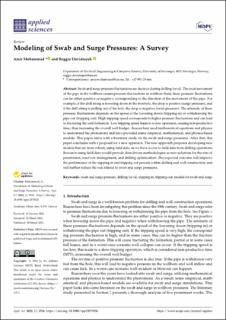| dc.contributor.author | Mohammad, Amir | |
| dc.contributor.author | Davidrajuh, Reggie | |
| dc.date.accessioned | 2022-06-23T10:43:03Z | |
| dc.date.available | 2022-06-23T10:43:03Z | |
| dc.date.created | 2022-04-24T13:14:03Z | |
| dc.date.issued | 2022-03 | |
| dc.identifier.citation | Mohammad, A., & Davidrajuh, R. (2022). Modeling of Swab and Surge Pressures: A Survey. Applied Sciences, 12(7), 3526. | en_US |
| dc.identifier.issn | 2076-3417 | |
| dc.identifier.uri | https://hdl.handle.net/11250/3000225 | |
| dc.description.abstract | Swab and surge pressure fluctuations are decisive during drilling for oil. The axial movement of the pipe in the wellbore causes pressure fluctuations in wellbore fluid; these pressure fluctuations can be either positive or negative, corresponding to the direction of the movement of the pipe. For example, if the drill string is lowering down in the borehole, the drop is positive (surge pressure), and if the drill string is pulling out of the hole, the drop is negative (swab pressure). The intensity of these pressure fluctuations depends on the speed of the lowering down (tripping in) or withdrawing the pipe out (tripping out). High tripping speed corresponds to higher pressure fluctuations and can lead to fracturing the well formation. Low tripping speed leads to a slow operation, causing non-productive time, thus increasing the overall well budget. Researchers used mathematical equations and physics to understand the phenomena and have provided many empirical, mathematical, and physics-based models. This paper starts with a literature study on the swab and surge pressures. After that, this paper concludes with a proposal for a new approach. The new approach proposes developing new models that are more robust, using field data, as we have access to field data from drilling operations. Research using field data would provide data-driven methodologies as new solutions for the rate of penetration, reservoir management, and drilling optimization. The expected outcome will improve the performance of the tripping in and tripping out process within drilling and well construction, and will further reduce the risk related to swab and surge pressures. | en_US |
| dc.language.iso | eng | en_US |
| dc.publisher | MDPI | en_US |
| dc.rights | Navngivelse 4.0 Internasjonal | * |
| dc.rights.uri | http://creativecommons.org/licenses/by/4.0/deed.no | * |
| dc.subject | petroleumsteknologi | en_US |
| dc.title | Modeling of Swab and Surge Pressures: A Survey | en_US |
| dc.title.alternative | Modeling of Swab and Surge Pressures: A Survey | en_US |
| dc.type | Peer reviewed | en_US |
| dc.type | Journal article | en_US |
| dc.description.version | publishedVersion | en_US |
| dc.rights.holder | © 2022 by the authors | en_US |
| dc.subject.nsi | VDP::Teknologi: 500::Berg‑ og petroleumsfag: 510 | en_US |
| dc.source.volume | 12 | en_US |
| dc.source.journal | Applied Sciences | en_US |
| dc.source.issue | 7 | en_US |
| dc.identifier.doi | 10.3390/app12073526 | |
| dc.identifier.cristin | 2018651 | |
| dc.source.articlenumber | 3526 | en_US |
| cristin.ispublished | true | |
| cristin.fulltext | original | |
| cristin.qualitycode | 1 | |

